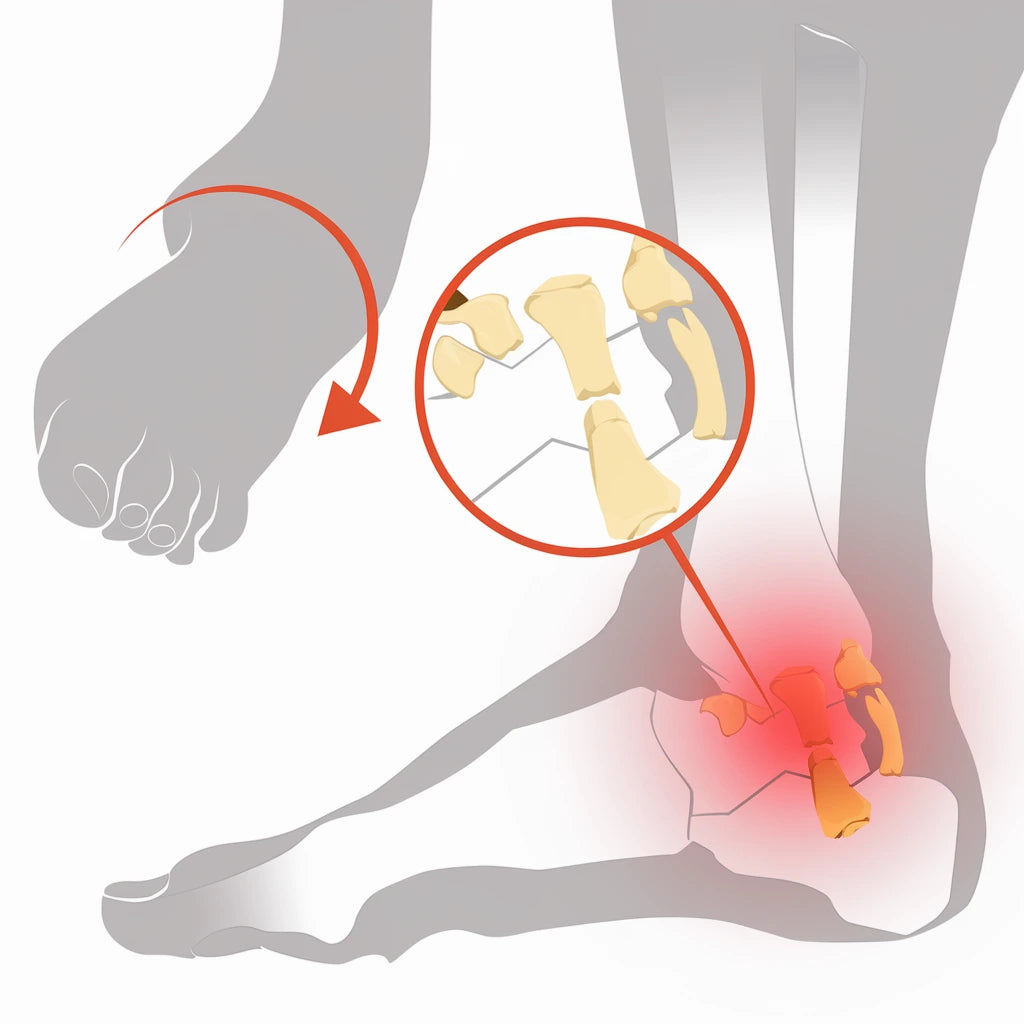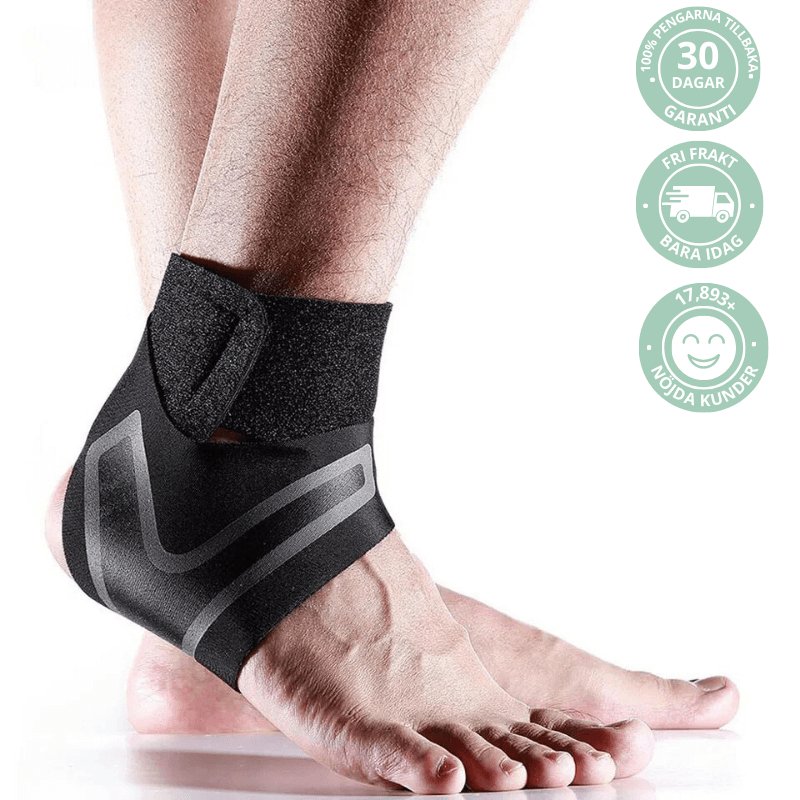Foot Fracture: Symptoms, Treatment, and Recovery

A broken foot is a serious injury that requires immediate medical attention. This article reviews the most common symptoms, treatment methods, and recovery process for a broken foot.
What is a broken bone in the foot?
A foot fracture occurs when one or more of the 26 bones in the foot is subjected to a force that exceeds its strength. This can range from small cracks to complete fractures. Fractures can occur when you step on something wrong or fall, and the injury doesn't have to mean the bone breaks completely – you can also have a crack in the bone tissue.
The foot is made up of several parts, including the forefoot with the metatarsal bones, the midfoot, and the ankle. Different types of fractures can occur in these areas, from stress fractures (also called marching fractures) to more serious open fractures. Children are more likely to sustain a bone injury in situations where adults would suffer a sprain, because children's bones are softer. You can read more about sprained feet and their symptoms here .
Symptoms of a broken bone in the foot
Common symptoms include:
- Intense pain in the injured area that worsens when you put weight on the foot
- Swelling around the foot and ankle that can occur quickly
- Bruising or redness on the injured area
- Difficulty supporting your foot or limping when walking
- Abnormal mobility or misalignment of the foot
- Tenderness to the touch
- Limited mobility in the foot or toes
- Pain that is not relieved by rest
- Difficulty putting on shoes due to swelling
It can sometimes be difficult to tell the difference between a sprain that has healed and a broken bone. Both can cause swelling and pain, but the symptoms of a broken bone are often more intense. If you are unsure, you should always seek medical attention for a proper diagnosis, especially if you are unable to stand on your foot. A similar condition with overlapping symptoms is foot overuse .
Diagnosis and treatment of foot fractures
A broken bone in the foot can be caused by accidents, overuse or trauma. In order to receive proper treatment, it is important to first make the correct diagnosis, often using several different examination methods. Treatment options are then selected depending on the severity of the fracture.
Common diagnostic methods and treatments
1. Physical examination
Treatment: Immobilization with plaster.
Benefit: Provides extra support and stability to the foot and reduces the risk of misalignment.
2. X-ray
Treatment: Surgery for more complicated fractures where the bone needs to be fixed.
Benefit: Distributes pressure evenly and restores foot function.
3. CT or MRI
Treatment: Pain relief with painkillers, often for minor fractures or while waiting for other treatment.
Benefit: Improves the position of the foot and makes it easier to manage pain during healing.
4. Ultrasound
Treatment: Physiotherapy with exercises to restore mobility and strength.
Benefit: Supports recovery and helps the foot return to normal function.
Rehabilitation and recovery after a broken foot
After initial treatment, the recovery process is crucial:
- Rest and relieve the foot as directed by your doctor.
- Gradual return to normal activity under supervision
- Perform recommended exercises to strengthen the foot and regain mobility
- Use supportive aids like the FootSupport 2.0 for extra stability
- Follow regular check-ups to ensure healing is progressing as it should.
- Be alert for signs of complications such as increased pain or swelling
Healing time varies depending on the type and location of the fracture. Simple fractures can heal in about six weeks, while more complex fractures can take several months. Children often heal faster because their bones grow and heal faster. If plates or screws have been surgically inserted, these are usually removed when they are no longer needed, especially in younger children. Some patients may also experience burning feet during rehabilitation.

How the FootSupport 2.0 can help with foot fractures
The FootSupport 2.0 is a specially designed foot insert that can be particularly valuable during the recovery process:
- Provides extra support and stability to the foot when you start putting weight on it again
- Distributes pressure evenly to reduce strain on the injured area
- Improves foot position and function during the healing process
- Can be used in different types of shoes for consistent support
- Helps prevent future damage by correcting faulty loads
- May relieve discomfort and pain when returning to normal activity
- Supports the foot long-term after the cast is removed
The FootSupport 2.0 can be a valuable complement to traditional treatment and rehabilitation. It is usually used after the acute phase of healing has passed and you have been allowed to gradually start putting weight on your foot again.
Buy nowConclusion
A broken foot is a serious injury that requires professional medical care. With the right treatment and support, including the use of assistive devices like the FootSupport 2.0, most people can recover well from a broken foot. It is important to follow your doctor's instructions carefully and be patient during the healing process to achieve the best possible results and reduce the risk of long-term complications.
Frequently Asked Questions (FAQ)
How long does it take for a broken bone in the foot to heal?
Healing time varies depending on the severity and location of the injury, but can take from 6-8 weeks to several months. Simple toe fractures heal faster than complex metatarsal or ankle fractures.
Can I walk with a broken bone in my foot?
It depends on the type and location of the fracture. Always follow your doctor's advice about weight bearing and the use of aids such as crutches or special shoes. In some cases, you can partially bear weight on the foot with the support of aids, while other fractures require you to completely relieve the foot.
When can I start using the FootSupport 2.0 after a broken leg?
Consult your doctor or physiotherapist about when it is appropriate to start using the Foot Support 2.0, usually after the initial healing has occurred and the cast has been removed. The insert can be especially valuable during the rehabilitation phase.
Do all foot fractures require surgery?
No, many foot fractures can be treated without surgery. Treatment depends on the type, location, and severity of the fracture. Stable fractures where the bones are still in the correct position are often treated with just a cast or special shoe.
How can I prevent future foot fractures?
Wear appropriate footwear, be careful on uneven surfaces, strengthen your foot and leg muscles, and use supportive inserts like the FootSupport 2.0 to improve foot function and stability. Be especially mindful in situations where you could step sideways or fall.

